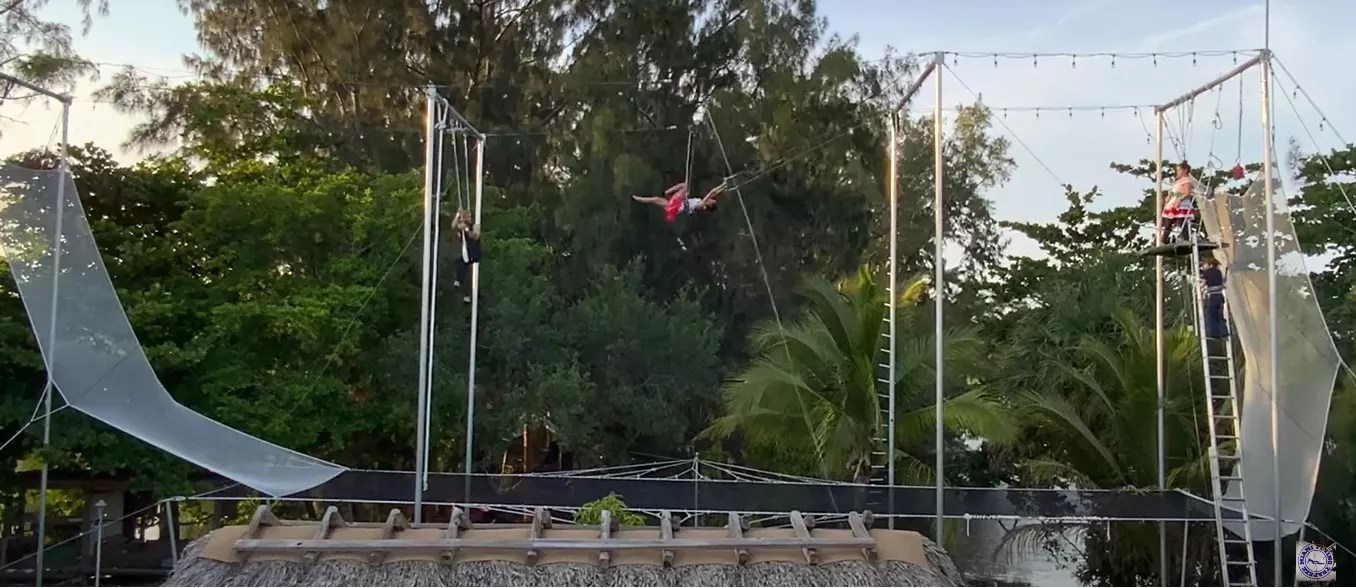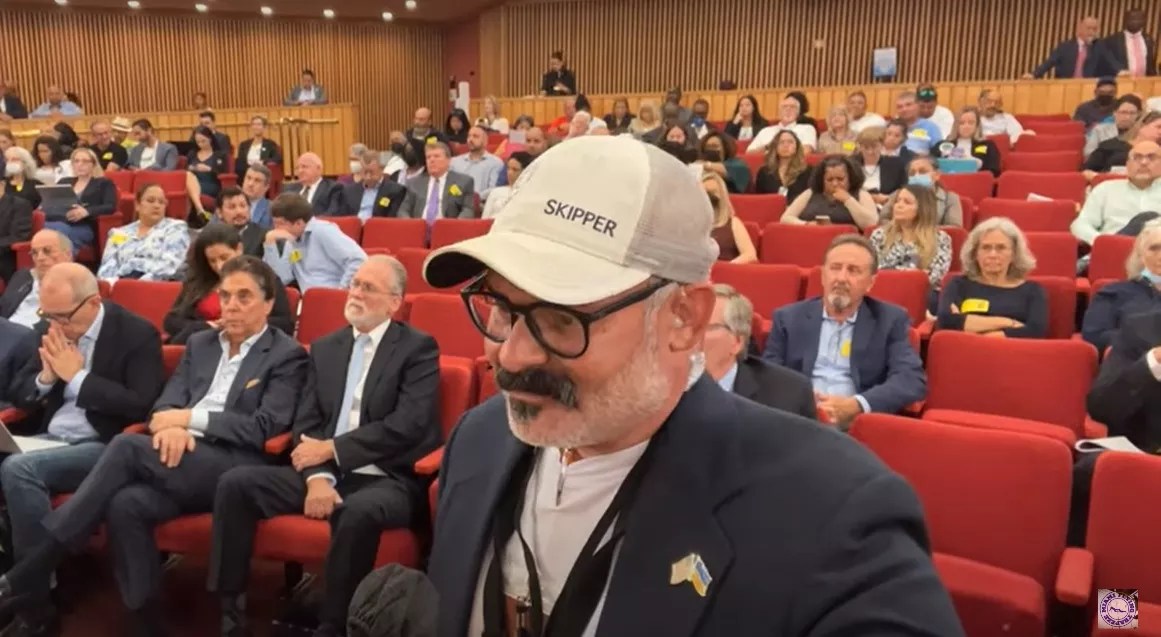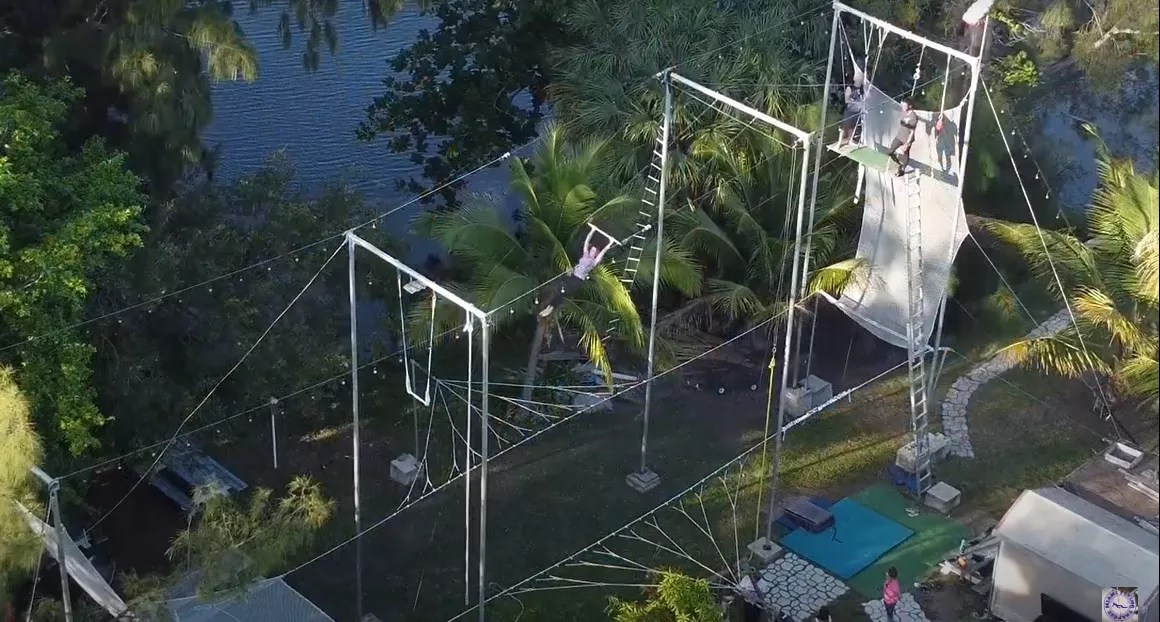
Miami Flying Trapeze screenshot via YouTube

Audio By Carbonatix
Life was looking up for acrobat Miguel Quintero until Miami-Dade code officers used high-flying images to search for violations at his Miami-area home, where he was running a circus-size trapeze in his backyard.
The veteran trapeze artist claims the county inspected the overhead photos as part of a campaign to harangue him and shut down his home-based acrobatics school, Miami Flying Trapeze. Code enforcement later pelted him with more citations in retaliation for publicly documenting the dispute, he claims.
“Why didn’t they just go get a warrant? Because they knew no judge would allow it,” he tells New Times.
The long-running tiff has inspired Quintero to produce a series of YouTube videos about constitutional rights and mount a longshot run for mayor of Miami-Dade County.
Quintero claims he’s also taken out a loan to fund his legal battle against the county. He recently refiled a civil rights claim alleging code inspectors violated his Fourth Amendment rights by walking around his property without permission, issuing retaliatory citations, and using the bird’s-eye-view photos, which the county says are publicly available aerial or satellite images.
“I mortgaged my home to the tune of $150,000 and was on the brink of divorce.”
“I mortgaged my home to the tune of $150,000 and was on the brink of divorce,” Quintero says. “That is how strongly I believe in the rule of law and in this case.”
The county first zoomed in on Quintero in 2021 after finding out that he was running a trapeze school behind his three-bedroom lakeside home in the Pinewood community. As New Times previously reported, he and his students use his supersized trapeze rig to flip, twirl, and glide into each other’s arms dozens of feet above the ground. Quintero describes the apparatus as a modular rig that can be readily broken down or reassembled – i.e., it is not a permanent installment on the property.
Claiming Quintero lacked a business certificate for the school, the county told him he could use the rig for personal but not commercial purposes. He says he took down online ads for the school per the county’s request, relying on its assurance that it would drop the case if he obliged.
The saga was far from over, however.
In 2022, Miami-Dade issued Quintero a slew of code violations for failure to obtain building permits for a utility shed and the trapeze set, improper plans for a tiki hut, an expired solar roof permit, and an illegal addition. Quintero says that when he came across a photo in his code violation file, he discovered the county was going to great heights to search his property – having conducted an “electrical inspection” using aerial images.
Though he refiled his case in a new venue (federal court instead of Miami-Dade County court), Quintero is using some familiar arguments.
As he did previously, Quintero describes the photos as “drone images” in an attempt to apply a Florida law prohibiting warrantless drone searches of private property. He claims that the airborne device that snapped the photos meets the definition of a “drone” in the state statute. (For your edification, the statute defines a drone as an “aerial vehicle” that “uses aerodynamic forces to provide vehicle lift, can fly autonomously or be piloted remotely,” and “can be expendable or recoverable,” among other criteria.)
According to the Electronic Frontier Foundation (EFF), surveillance drones and other unmanned aerial systems raise significant issues for privacy and civil liberties.
“The law is unsettled,” EFF staff attorney Hannah Zhao tells New Times. “Mr. Quintero has good grounds for arguing this case.”
The ad coelum theory holds that an owner’s property extends “all the way to heaven and all the way to hell.”
If Quintero falls flat on proving the images were created by drones, he may face a more challenging path in establishing he was the victim of an unconstitutional search. Modern law has eaten away at the theory of ad coelum – a maxim traced back at least 800 years to the Italian legal scholar Franciscus Accursius – which holds that an owner’s property extends “all the way to heaven and all the way to hell.”
A series of U.S. Supreme Court cases have found that manned airplane and helicopter searches in the publicly navigable airspace above a person’s property generally do not amount to unconstitutional intrusions so long as they only observe readily visible, outside areas. That’s been the gist of the case law since a 1986 ruling in California v. Ciraolo, where the high court held that investigators didn’t violate a man’s constitutional rights by flying over his property in a private plane to spot a marijuana crop in his backyard.
But the use of high-end technology in surveillance muddies the waters (echem, sullies the skies) on unlawful searches.
In Kyllo v. United States, federal agents were found to have performed an unlawful search when they deployed thermal imaging to bust a pot-cultivation operation in Oregon. The Supreme Court focused on how the Thermovision scanning system was a specialized, high-tech tool, not in public use, and how agents therefore crossed the bounds of simple observation into the realm of a warrantless search. The majority opinion noted it was taking the “long view” of constitutional rights in light of technological developments in surveillance.
Further complicating matters in the trapeze artist’s case, the Miami-Dade County code enforcement department says it does not independently conduct drone searches of homes. The department says the overhead photos it reviews are pulled from public records, such as the county property appraiser’s website.
While the appraiser’s website allows the public to view property using apparent satellite images, the site also provides detailed “angled aerial views” of property.
EFF tells New Times that even if the images are publicly available satellite photos, residents “have a reasonable expectation of privacy in the ‘curtilage’ around the house including the backyard, which means the government must obtain a warrant prior to surveilling that area” under current case law.
“Legislation and regulations must keep pace with reality to ensure that our privacy rights do not shrink as technology advances,” Zhao says.

Miguel Quintero, AKA “Skipper,” at a 2022 Miami-Dade County meeting
Miami Flying Trapeze screenshot via YouTube
The last time Quintero took Miam-Dade to court, the county’s attorneys claimed Quintero failed to show code inspectors intruded on his property. The code officers on the ground inspected publicly visible areas of Quintero’s home – activity that does not constitute a warrantless search, the lawyers said. As for the high-flying photos, the county claimed the attempt to frame them as a product of “drone” inspections defied logic.
The presiding judge never got around to addressing the more intriguing elements of Quintero’s previous case. He dismissed the complaint late last year on a procedural issue, finding that Quintero did not follow pre-suit legal procedures before bringing his claims to court.
Besides his unlawful search claims, Quintero’s new federal case has a First Amendment claim alleging the county precluded him from video recording at voting sites at the Joseph Caleb Center in Liberty City and at Miami Dade College’s North Campus in 2022.
The following year, when he protested the “county’s drone surveillance program” and tried to film a commission meeting from an area reserved for media, a police officer asked him to leave, the lawsuit says.
“Despite Quintero’s explanation that he is an independent journalist, that he has a background in journalism, and that he planned to broadcast the meeting on YouTube, the officer threatened to physically remove him,” the complaint claims.
Quintero adds that in September 2022, after he protested outside a county building and created YouTube videos about the saga, code enforcement returned to his home and harassed him further. He claims they cited him for a trailer on his property in retaliation for speaking out against the county and bringing the dispute to light.

Miguel Quintero records trapeze artists performing on his backyard circus rig.
Miami Flying Trapeze screenshot via YouTube
Quintero’s lawsuit names as defendants Miami-Dade County, the county’s chief zoning officer, four code officers, and the deputy supervisor of elections.
Quintero is asking a federal judge to:
- Find that the county violated his Fourth Amendment rights through an unlawful aerial inspection and on-the-ground searches.
- “Declare that Miami-Dade County’s policy of allowing code enforcement officer to enter private property without a warrant or consent is unconstitutional.”
- “Declare that Miami-Dade County’s policy of requiring members of the public to obtain a ‘press pass’ in order to film in public areas is an unconstitutional restraint on a citizen’s right to record the government.”
- “Enter an order precluding Miami-Dade County officers, officials, and agents from photographing and publishing images of citizens’ property without their consent during regulatory checks.”